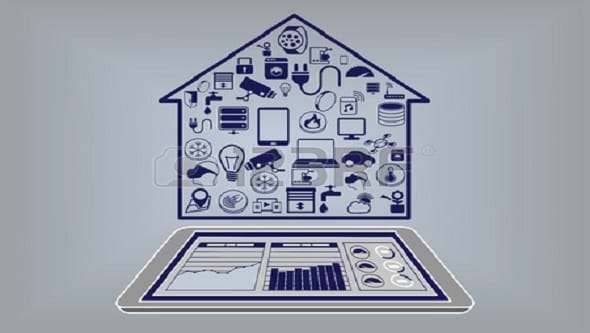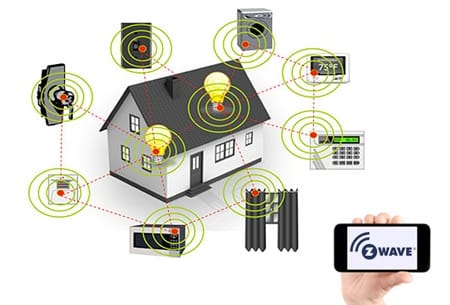
In a day and age when everybody is glued to their electronics (myself included), the terms “smartphone,” “smartwatch” and “smart car” are ubiquitous. The idea of the “smart home” and home automation may be lesser known, but comes with infinitely more possibilities.
To understand the appeal of making your home “smart,” you need to know why home automation (or any kind of automation, really) came about in the first place. The earliest examples of home automation date back over 100 years, when washing machines, dryers, dishwashers, water heaters and refrigerators were introduced to modern society. These devices were intended to help solve problems, make our lives easier, remove sources of stress and, in some instances, help us become (or at least feel) safer. Modern-day home automation is no different.
So, what elements go into home automation? The list is impressive, but before you start designing your smart home, there are three key things you will need to decide:
What standard (protocol) will you use?
The protocol basically dictates how the devices you use “speak” to each other and to the centralized hub. Most protocols use radio frequency (RF), but others use dedicated data lines. Examples include:
- Z-Wave: The reigning king of the smart home, and for good reason. It is the most widely supported protocol (besides x-10, which is the oldest protocol around), which means that you can generally get Z-Wave devices at good prices. Z-Wave runs off of RF, and one of its biggest advantages is that it uses a mesh network, meaning all Z-Wave devices in your grid will pair with each other. That means if one device is unable to contact a second device on the other
side of the house due to radio interference, the message can be relayed to a device in adifferent room, which will route it to the target without interference. - Zigbee: A very popular open wireless protocol.
- Wi-Fi: A good solution for smart home protocols, although it hasn’t quite taken off to the same degree as Z-Wave. As such, prices are generally higher.
Which controller or HUB will you use?
The HUB/controller is what runs the entire smart home system. Through it, you can create and process rules and groups of rules that run together in response to a specific triggered event. Some controllers can actually be run off of a server/workstation in your home. Some popular choices include:
- Samsung SmartThings: Favored by many, this cloud-based solution is compatible with most Z-Wave devices and charges no monthly fees. It’s also compatible with Amazon’s Alexa and has an IFTTT channel.
- Wink: This popular hub by GE is compatible with Amazon’s Alexa and has an IFTTT channel.
- Lowe’s IRIS: This Lowe’s-provided system offers basic service free of charge, but in order to create rules, you must pay $10 per month.
- Homeseer: One of the most powerful controllers currently out there, Homeseer supports a huge range of devices. Unlike any of the previously mentioned products, if your internet connection goes out at home, your house still behaves as if it were up. It is on the pricier side, however, but offers two controller options: hardware with software preconfigured, or software that allows you to install where you’d like it to run.
What devices do you actually want to run (in) your home?
This is where things get exciting, because it’s all about what a smart house can actually do! The possibilities are almost endless, but I’ve put together a list of the most common ones:
-
- Voice control: Imagine telling your Amazon Alexa-enabled device to add things to your shopping list, play music, turn on a light, purchase something from amazon.com or lower the AC with a simple voice command. Examples include:
- Amazon Echo, Touch and Dot: Amazon’s Alexa product, which is far and away the most popular currently.
- Google Home: Not out yet but, per Google, will be hitting the market shortly.
- Heating and cooling: Imagine scheduled heating/cooling with temperature sensors in different rooms that know where and when to ramp up or down. Examples include:
- Cameras for video monitoring: Imagine continuous video recording that is set to text you, call you or create a time-stamped note in a spreadsheet located in your Google Drive. Examples include:
- Smart plugs: Imagine if your old coffee-maker could start making your coffee as soon as you turn on the power. Smart plugs attach to your regular power outlets but have their own outlet extension, which allows you to control them from your smartphone. Examples include:
- Water management/irrigation (sprinklers, water sensors, water valves): Imagine being able to set up your home so your watering schedule will auto-postpone if rain is coming. Examples include:
- Energy management: See how much power you are consuming and turn off plugged-in devices when they’re not in use… even when you’re not home.
- Voice control: Imagine telling your Amazon Alexa-enabled device to add things to your shopping list, play music, turn on a light, purchase something from amazon.com or lower the AC with a simple voice command. Examples include:
-
- Garage door opener: Imagine your garage door opening automatically when you’re a quarter-mile away. Or, if you’re at work and remember you left the door open, picture being able to simply hit a button on your phone to close it. Examples include:
- Door locks: If you have someone coming over for dinner and are too busy in the kitchen to let them in, imagine being able to speak to your system to unlock the door. Alternatively, if you are at work when the maid service comes by, you don’t need to keep the door unlocked or run home; you can just unlock the door from your phone and lock it again when they are through. Examples include:
- Lights/switches: Imagine your lights flipping on as soon as motion is detected in a
room. If there is no motion detected in that room for three minutes, the lights will turn off. Examples include:
- Motion detection: You can tie motion detecting into pretty much any other device to trigger rules. Examples include:
- Security systems: Imagine if an event picked up by motion sensor or video triggered a call to you or someone else. Examples include:
- Sensors (carbon dioxide, smoke, earthquake, temperature, door/window, motion): If your smoke sensor hits its threshold or the window sensor plane is broken, this will automatically trigger a call to 911.
So how should you, the interested consumer, approach this jungle of choices? Begin by picking what’s important to you. If your summer cooling bill is a big pain point, then maybe you could start with an ecobee3 thermostat and set up a schedule for turning it on and off from your phone. From there, you may want to move into controlling lighting. There is no set-in-stone methodology to choose features, so just do what you want and expand from there.
My personal recommendations
I expect to close on my new house soon and will be doing what I can to automate as much as possible. I’ve already got a rough outline of what I want to do and the order in which I want to do it:
- I’ll be going with Z-Wave protocol since that is the most widely supported protocol. Also, its prices will continue to lower as more manufacturers enter the fray.
- For a HUB, I’ll be purchasing a HomeSeer software license and installing that on the server in my house for more control over creating rules/triggers/events. I highly value the idea that no part of my automation system will be in another company’s cloud, and I want the assurance that my house won’t be “turning off” if/when it loses internet.
- My biggest priority is always security, so I’ll be installing 5 Hikvision IP cameras and getting a Blue Iris NVR software license.
- Cooling is another big point for me, so I’ll immediately be putting in an ecobee3 or Sensi unit along with an Alexa-enabled device in the kitchen/living room, my office and the bedroom to raise/lower the temperature.
- Lighting will probably be my next stop, and I’ll most likely be going with these Linear switches.
I’m very excited about this upcoming project, and I know at least two other friends who are or soon will be making their houses smarter! We all have different ideas about what to do and with what brand, which will make each house unique. In the end, creating my smart house is going to reduce or remove a lot of stresses from my everyday life and make the time that I spend at home more enjoyable. Now, if only I could automate myself…
The purpose of this blog is to answer the questions you ask! And while you may not have asked about home automation- now you’re all the “smarter” for it! If you want know more about all things “smart” – check out posts from my colleagues on industry news and tech tips!




